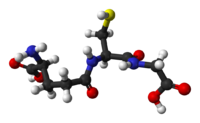
Photo from wikipedia
Antioxidants are known to exhibit a protective effect against reactive oxygen species (ROS)-related oxidative damage. As a result, inclusion of exogenous antioxidants in the diet has greatly increased. In this… Click to show full abstract
Antioxidants are known to exhibit a protective effect against reactive oxygen species (ROS)-related oxidative damage. As a result, inclusion of exogenous antioxidants in the diet has greatly increased. In this sense, detection and quantification of such antioxidants in various food and beverage items are of eminent importance. Monophenols and polyphenols are among the most prominent natural antioxidants. In this regard, biosensors have emerged as a simple, fast, and economical method for determination of such antioxidants. Owing to the fact that majority of the phenolic antioxidants are electroactive, oxidoreductase enzymes are the most extensively availed bioreceptors for their detection. Herein, the different types of oxidoreductases that have been utilized in biosensors for the biorecognition and quantification of natural phenolic compounds commonly present in foods and beverages are discussed. Apart from the most accustomed electrochemical biosensors, this review sheds light on the alternative transduction systems for the detection of phenolic antioxidants. Recent advances in the strategies involved in enzyme immobilization and surface modification of the biosensing platform are analyzed. This review aims to provide a brief overview of the latest developments in biosensor technology for phenolic antioxidant analysis in foodstuffs and future directions in this field.
Journal Title: ACS Omega
Year Published: 2022
Link to full text (if available)
Share on Social Media: Sign Up to like & get
recommendations!